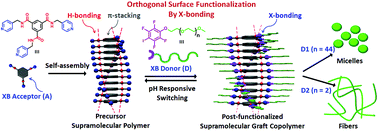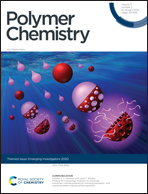A pH-responsive graftable supramolecular polymer with tailorable surface functionality by orthogonal halogen bonding and hydrogen bonding†
Abstract
Inspired by nature, the field of supramolecular assembly is largely dominated by hydrogen (H)-bonding interactions. However, the scope of H-bonding driven assembly is limited in aqueous medium due to competing solvent interactions. This makes solvent-resistant halogen (X)-bonding an alternative emergent tool for molecular recognition in aqueous milieu. A unique supramolecular strategy based on two orthogonal directional interactions, hydrogen bonding and halogen bonding, has been described to constitute a graftable supramolecular polymer in water. The backbone of the supramolecular polymer is composed of a benzene-1,3,5-tricarboxamide (BTA) core with three pyridyl motifs on the periphery that can participate as both X- and H-bond acceptors. While threefold H-bonding and concomitant π-stacking within the hydrophobic core trigger the formation of the precursor supramolecular polymer, the pendant reactive pyridyl acceptors regulate the outer surface functionality by means of X-bonding with complementary X-bond donating iodotetrafluorophenyl based moieties. By employing this design principle, both X-bond donating polyethyleneglycol (mol wt = 2000 Da) and short triethyleneglycol chains were grafted to the polymer backbone that triggers the formation of spherical micelles and 1D fibers, respectively, in water. pH responsive denaturing of X-bonds leads to reversible switching from the graft copolymer to the precursor BTA polymer in acidic pH as evident from reversible morphology transition from micelles to nanofibers. Contrastingly, control PEG-OH lacking an X-bond donating unit at the chain end could not be grafted to the supramolecular polymer, as bulk water competes for H-bonding with the hydroxyl group on the outer surface of the supramolecular polymer. The present study demonstrates X-bonding as a more attractive tool for non-covalent surface functionalization in water, where hydrophobic shielding is a prerequisite for the performance of ubiquitous H-bonding. The present design offers new insight into the development of multi-component pH responsive complex molecular assemblies.

- This article is part of the themed collection: Polymer Chemistry Emerging Investigators


 Please wait while we load your content...
Please wait while we load your content...